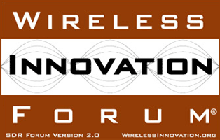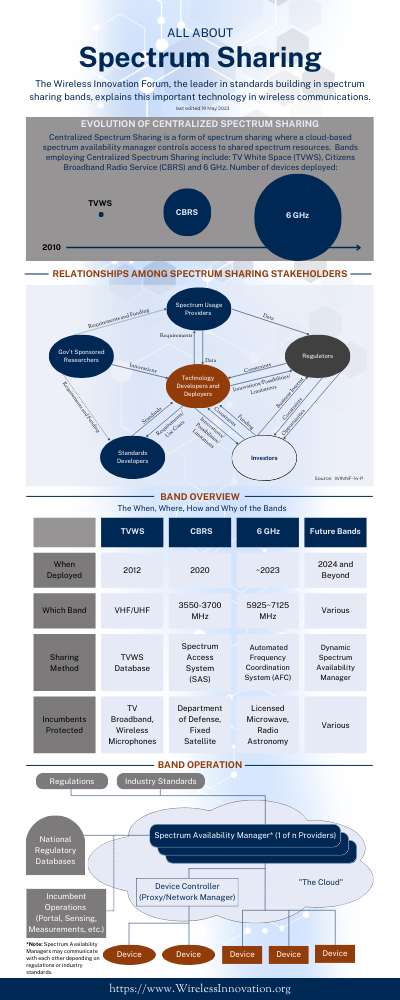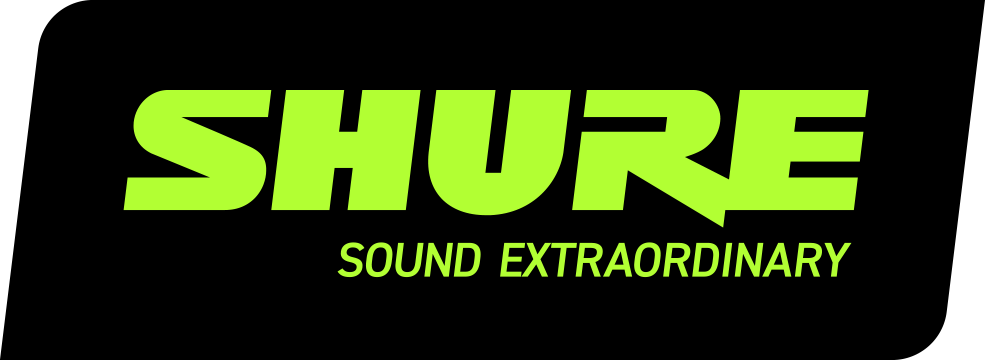For additional information related to Software Defined Radio, visit the following sites.Market Forecast and Analyst information can be found on our Member Discounts page. Also visit the list of all Wireless Innovation Forum Member Organizations and Wireless Innovation Forum Partners. Resources & Links List3GPP - Market Representation Partners
http://www.3gpp.org
Standards Organizations
The 3rd Generation Partnership Project is developing technical specifications for IMT-2000, the International Telecommunication Unions (ITU) framework for third-generation standards. Includes CWTS & GSM MoU.
Association of Radio Industries & Business ARIB
http://www.arib.or.jp
Standards Organizations
The objectives of ARIB are to conduct investigation, research & development and consultation of utilization of radio waves from the view of developing radio industries, and to promote realization and popularization of new radio systems in the field of telecommunications and broadcasting.
China Communications Standards Association
http://www.cwts.org/english/
Standards Organizations
Chinas communications standard organization, created on the basis of existing standard working groups, is a nationwide unified communications standardization organization that is compatible with international norms and Chinese situations and capable of meeting the needs in the market.
Cognitive Networking Alliance (CogNeA)
http://www.cognea.org/v01/
Industry Group
The CogNeA alliance unites influential players in the consumer electronics, personal computing, home entertainment, semiconductor and digital imaging spaces in a unified effort to help drive the definition and adoption of industry-wide standards for low-power personal and portable wireless devices to operate over the TV white spaces.
Electronics and Telecommunications Research Institute (ETRI)
http://www.etri.re.kr/eng/
Regional Research Group
Wireless Innovation Forum Member Established in 1976, ETRI is a non-profit government-funded research organization that has been at the forefront of technological excellence for more than 30 years. The research institute has successfully developed information technologies such as TDX-Exchange, High Density Semiconductor Microchips, Mini-Super Computer (TiCOM), and Digital Mobile Telecommunication System (CDMA).
End-to-End Efficiency Program (E3)
https://ict-e3.eu/project/overview/overview.html
Related Sites
Wireless Innovation Forum partner The key objective of the E3 project is to design, develop, prototype and showcase solutions to guarantee interoperability, flexibility and scalability between existing legacy and future wireless systems, manage the overall system complexity, and ensure convergence across access technologies, business domains, regulatory domains and geographical regions.
European Commission (EC)
http://ec.europa.eu/index_en.htm
Regulatory Agency
The European Commission (formally the Commission of the European Communities) is the executive branch of the European Union. The body is responsible for proposing legislation, implementing decisions, upholding the Unions treaties and the general day-to-day running of the Union.
European Conference of Postal and Telecommunications Administrations (CEPT)
http://www.cept.org/
Regulatory Agency
The European Conference of Postal and Telecommunications Administrations - CEPT - was established in 1959 by 19 countries, which expanded to 26 during its first ten years. Original members were the monopoly-holding postal and telecommunications administrations. CEPTs activities included co-operation on commercial, operational, regulatory and technical standardisation issues.
Federal Communications Commission (FCC)
http://www.fcc.gov/
Regulatory Agency
The Federal Communications Commission (FCC) is an independent United States government agency. The FCC was established by the Communications Act of 1934 and is charged with regulating interstate and international communications by radio, television, wire, satellite and cable. The FCCs jurisdiction covers the 50 states, the District of Columbia, and U.S. possessions.
GSMA
http://www.gsmworld.com/
Relevant Forums/Societies
The GSMA represents the interests of the worldwide mobile communications industry. Spanning 219 countries, the GSMA unites more than 750 of the world’s mobile operators, as well as 200 companies in the broader mobile ecosystem, including handset makers, software companies, equipment providers, Internet companies, and media and entertainment organisations.
IEEE SCC 41 (Dynamic Spectrum Access Networks)
http://www.scc41.org
Related Sites
The IEEE P1900 Standards Committee was established in the first quarter 2005 jointly by the IEEE Communications Society (ComSoc) and the IEEE Electromagnetic Compatibility (EMC) Society. The objective of this effort is to develop supporting standards dealing with new technologies and techniques being developed for next generation radio and advanced spectrum management.
IEEE Standards Association
http://standards.ieee.org/
Standards Organizations
Wireless Innovation Forum partner The IEEE is a leading developer of standards that underpin many of todays technologies. With nearly 1,300 standards either completed or under development, they are a central source of standardization in both traditional and emerging fields, particularly telecommunications, information technology and power generation.
Industry Canada
http://www.ic.gc.ca/eic/site/ic1.nsf/eng/home
Regulatory Agency
The Departments mission is to foster a growing, competitive, knowledge-based Canadian economy. Program areas include developing industry and technology capability, fostering scientific research, setting telecommunications policy, promoting investment and trade, promoting tourism and small business development, and setting rules and services that support the effective operation of the marketplace.
Institute of Electronics Engineers of Korea (IEEK)
http://www.ieek.or.kr/eng/
Related Sites
Wireless Innovation Forum partner The mission of The Institute of Electronics of Korea is to organize and conduct various activities and projects designed to promote the growth and expansion of academic information and technological advancement in the fields relating to electronics, information, and communication.
Institute of Electronics, Information and Communications Engineers (IEICE)
http://www.ieice.org/eng/index.html
Regional Research Group
Being known internationally as one of the worlds leading academic institutions in this area, the IEICE aims at the investigation and exchange of knowledge on the science and technology of electronics, information and communications, and contributes to the progress of technologies and to the development of industries.
International Organization for Standardization (ISO)
http://www.iso.org/iso/home.htm
Standards Organizations
ISO is the worlds largest developer and publisher of International Standards. ISO is a network of the national standards institutes of 161 countries, one member per country, with a Central Secretariat in Geneva, Switzerland, that coordinates the system. ISO is a non-governmental organization that forms a bridge between the public and private sectors.
International Telecommunications Union Radiocommunication Sector (ITU-R)
http://www.itu.int/ITU-R/
Related Sites
Wireless Innovation Forum partner ITU is the leading United Nations agency for information and communication technology issues, and the global focal point for governments and the private sector in developing networks and services.
Internet Engineering Task Force
http://www.ietf.org/
Standards Organizations
The Internet Engineering Task Force (IETF) is a large open international community of network designers, operators, vendors, and researchers concerned with the evolution of the Internet architecture and the smooth operation of the Internet. It is open to any interested individual.
ITU World Radiocommunications Conference
http://tinyurl.com/lwww9w
Regulatory Agency
World Radiocommunication Conference (WRC) is organized by ITU to review, and, if necessary, revise the Radio Regulations, the international treaty governing the use of the radio-frequency spectrum and the geostationary-satellite and non-geostationary-satellite orbits. It is held every two to four years.
Joint Program Executive Office (JPEO) for Joint Tactical Radio System (JTRS)
http://jpeojtrs.mil/
Related Sites
Wireless Innovation Forum partner The JTRS program has evolved from separate radio replacement programs to an integrated effort to network multiple weapons system platforms and forward combat units where it matters most - the last tactical mile. JTRS will link the power of the Global Information Grid to the warfighter in applying fire effects and achieving overall battlefield superiority.
JTRS - Joint Tactical Radio System Software Communications Architecture (SCA)
http://sca.jpeojtrs.mil/
Related Sites
Wireless Innovation Forum partner The JTRS program has evolved from separate radio replacement programs to an integrated effort to network multiple weapons system platforms and forward combat units where it matters most - the last tactical mile.
Ministry of Internal Affairs and Communications
http://www.soumu.go.jp/english/
Regulatory Agency
To ensure the safe and reliable provision of a telecommunication infrastructure indispensable to civic life, and to enable its even higher advancement, the Telecommunication Bureau is in charge of the clerical work for: establishing a competitive base for the sound development of the telecommunication market; protecting consumers for the secure and reliable use of telecommunication service; providing assistance in arranging wired and wireless networks, and ; arranging policies and environments for using radio waves effectively.
Mobile VCE
http://www.mobilevce.com/
Related Sites
Wireless Innovation Forum partner Mobile VCE provides industrially-relevant, long-term, world-class, research in mobile and personal communications defined & steered by our industrial members.Its innovative structure accesses the highest quality academic skills and staff, whilst ensuring that research is industrially relevant, yields valuable intellectual property, and provides a very high financial gearing.
National Science Foundation (NSF)
http://www.nsf.gov/
Regional Research Group
The National Science Foundation (NSF) is an independent federal agency created by Congress in 1950 ""to promote the progress of science; to advance the national health, prosperity, and welfare; to secure the national defense…"" With an annual budget of about $6.06 billion, we are the funding source for approximately 20 percent of all federally supported basic research conducted by Americas colleges and universities. In many fields such as mathematics, computer science and the social sciences, NSF is the major source of federal backing.
Network Centric Operations Industry Consortium
http://www.ncoic.org
Relevant Forums/Societies
Wireless Innovation Forum partner The NCOIC is a unique collaboration of premier leaders in the aerospace, defense, information technology, large-scale integrator and services industries. The Consortium works in tandem with customers from around the world, each with a specific mission, to provide a set of tools that enable the development of network centric capabilities and products.
Object Management Group
http://www.omg.org
Relevant Forums/Societies
Wireless Innovation Forum partner The Object Management Group™ (OMG™) is an international, open membership, not-for-profit computer industry standards consortium. OMG member companies write, adopt, and maintain its standards following a mature, open process. OMGs standards include: Model Driven Architecture ,Unified Modeling Language™, and CORBA.
Ofcom
http://www.ofcom.org.uk/
Regulatory Agency
The Office of Communications or, as it is more often known, Ofcom, is the independent regulator and competition authority for the communication industries in the United Kingdom.
Telecom Industry Association (TIA)
http://www.tiaonline.org/
Standards Organizations
A national trade organization with more than 900 large and small companies which provide communications and information technology products and services.
UMTS Forum
http://www.umts-forum.org/
Industry Group
The UMTS Forum helps all players in this dynamic new value chain understand and profit from the opportunities of 3G/UMTS networks and their Long Term Evolution (LTE). The UMTS Forum participates actively in the work of the ITU, ETSI, 3GPP and CEPT as well as other technical and commercial organisations globally. It also contributes to the timely licensing and deployment of mobile broadband globally through regular dialogue with regulators and responses to public consultations.
VME Industry Trade Association (VITA) Standards Organization (VSO)
http://www.vita.com/vso-stds.html
Standards Organizations
Wireless Innovation Forum partner VITA is an incorporated, non-profit organization of suppliers and users having a common market interest in critical embedded systems. Founded in 1984, VITA believes in and champions open system architectures as opposed to proprietary system architectures. VITAs activities are international in scope. The functions performed by VITA are technical, promotional and user related and are aimed at increasing the total market size, providing vendors with additional market exposure, and providing users with timely technical information.
Wireless Network after Next Program (DARPA WNAN)
http://www.darpa.mil/sto/solicitations/WNaN/
Regional Research Group
The WNaN program seeks to develop and demonstrate technologies and system concepts that will enable intelligent adaptive wireless networks consisting of densely deployed low cost wireless nodes. The premise of the WNaN program is that significant advantages can be realized by densely deploying low cost nodes which have been jointly optimized with network operations.
Wireless World Research Forum (WWRF)
http://www.wireless-world-research.org/?id=92
Regional Research Group
Wireless Innovation Forum partner WWRF is a global organisation, which was founded in August 2001. It now has over 140 members from five continents, representing all sectors of the mobile communications industry and the research community. The objective of the WWRF is to formulate visions on strategic future research directions in the wireless field, among industry and academia, and to generate, identify, and promote research areas and technical trends for mobile and wireless system technologies.
|



